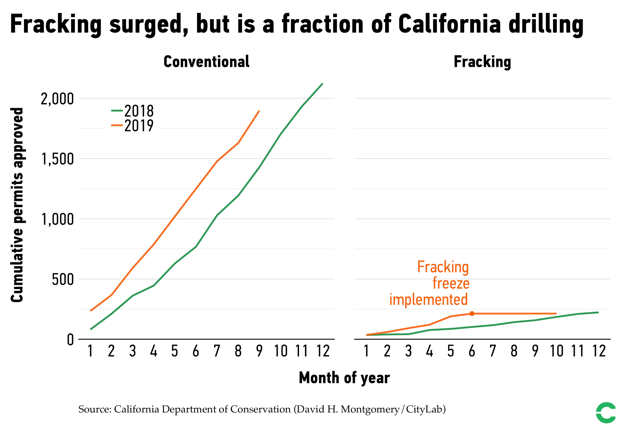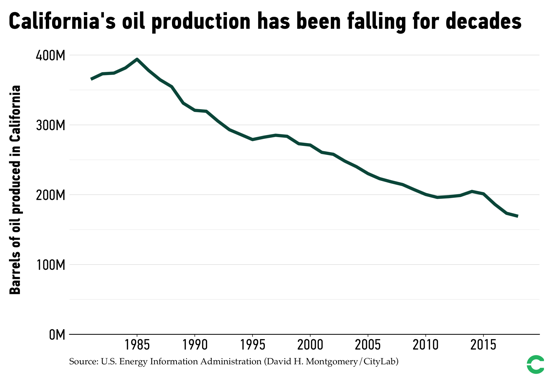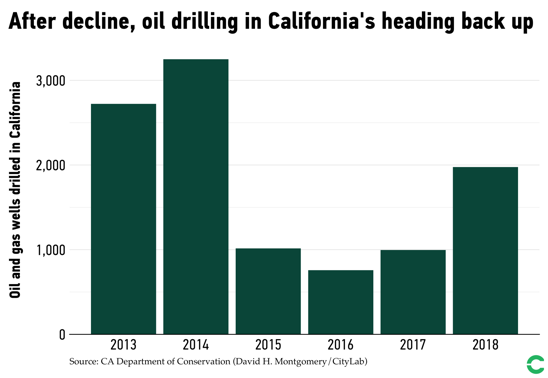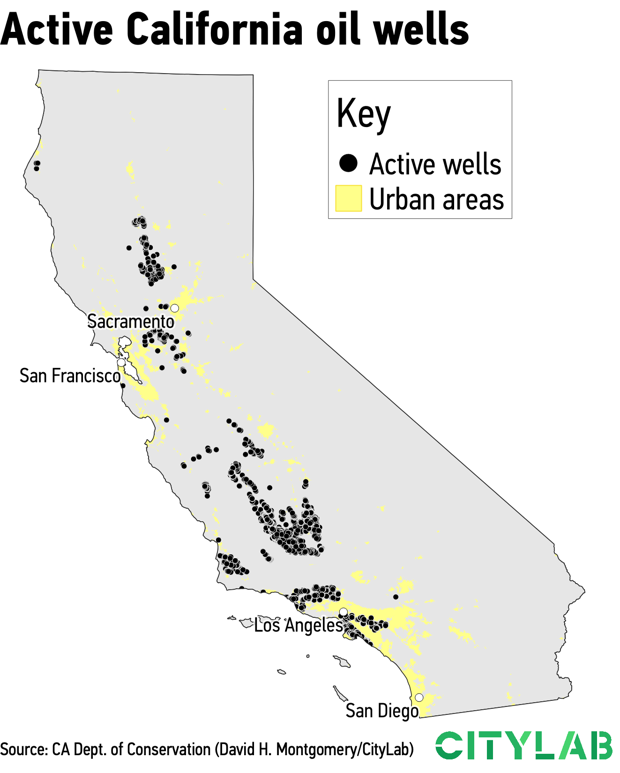Connecting state and local government leaders
Drilling and fracking permits are up since Governor Newsom took office. But it’s not totally clear why.
As Donald Trump’s administration pushes to expand oil extraction in California, the state’s governor, Gavin Newsom, has signed bill after bill limiting the practice. In October, new laws banned federal oil extraction on state lands, removed the terms “oil” and “gas” from the name of the state’s department of energy, and expanded its mandate to include public health and safety.
“California is a leader in the fight to transition away from fossil fuels,” Newsom said in a statement. “These bills put intentions into action … and fight against the Trump administration’s efforts to expand oil extraction in California.”
But since taking office in January, Newsom’s own department of energy management has approved 33 percent more new oil and gas drilling permits than were approved under Newsom’s predecessor Jerry Brown over the same period in 2018—a median of 174 permits to drill new oil, gas, and cyclic steam wells approved a month, based on Geologic Energy Management Division (CALGEM) reports analyzed by CityLab.
The rate of fracking permits approved also soared at the start of the year, up 109 percent through June.

The fact that fracking approvals in California had spiked in the new year was first reported in July by the FracTracker Alliance and Consumer Watchdog. Newsom responded quickly to the news, firing the head of the approving agency for employing regulators who owned stock in oil companies, and directing the department to stop approving fracking permits. Since June 28, California hasn’t cleared any new hydraulic fracturing projects.
Even with the cut-off of fracking approvals, California is still on track to end the year with a higher rate of oil and gas-related drilling permits overall. Still, permitting doesn’t correlate to actual oil extraction, experts note: the production of crude oil across California has steadily dropped since 1985, falling more than 50 percent by 2017 and bringing the state from the third-highest producer to the sixth. Information on crude oil production totals are not yet available for 2019.

But a cohort of activist organizations that call themselves the Last Chance Alliance are arguing that green-lighting any new drilling runs counter to the state’s environmental mandate, and poses a danger to communities in the immediate vicinity of the wells.
Brown, cast as a champion of environmental issues, cemented part of his legacy by passing State Bill 4, which regulated fracking in the state of California. Before the legislation came into effect in 2016, companies were able to conduct hydraulic fracturing procedures under the radar. Under SB4, the operators just had to adhere to stricter rules. As drillers worked to adjust to the new requirements, the number of oil and gas-related permits dropped precipitously.
“At first, SB4 was a real win because it reduced the number of permits being issued in California,” said Kyle Ferrar, the Western program coordinator for the FracTracker Alliance, an anti-fracking advocacy group. “But as the years went on, we saw that the difficulty or the restrictions that were in place for operators to drill new wells—the operators were able to get over those hurdles [more and more easily].”
By 2017, the permitting rate was starting to rebound. Over the course of Brown’s tenure, more than 20,000 new injection and production well permits were issued, according to Food and Water Watch, and more than 200 new wells were approved in state waters. Those approvals translated into action: After a sharp decline in new wells drilled between 2014 and 2016, there were marked increases in the footage and the number of wells drilled between 2017 and 2018, according to CALGEM’s website. Brown’s hesitance to regulate the oil and gas industry further inspired a cohort of public health and environmental advocacy organizations to come together to advocate for a halt to all new fossil fuel infrastructure in California, calling themselves Brown’s Last Chance. This year, they became the Last Chance Alliance, and are calling on Newsom to do what Brown didn’t.

The reasons behind the spike in fracking and oil and gas drilling permit approvals under Newsom so far are not clear and the governor’s office declined to comment. But one explanation is that, fearing a more aggressive crackdown from Newsom’s administration, oil and gas companies attempted to push new approvals through before the new governor started paying attention. As lieutenant governor, he’d taken a stand against offshore drilling; during his campaign, he’d refused to take contributions from the fossil fuel industry. “He’s going to be the pioneer of phasing out oil and gas extraction in California,” Kassie Siegel, director of the Center for Biological Diversity’s Climate Law Institute, told the Sierra Club after the election. “He’s going to be the leader the world needs on this.”
Alexandra Nagy, the California director of the advocacy organization and Last Chance Alliance member, Food and Water Watch, attributes the bump not to savvy political calculations, but to an oil industry that’s recovering from a 2014 bust, and heading into a boom. “The oil industry was never really dead,” she said. “They were lying dormant, and now they’re trying to come back and expand and reinvest and make more money off of their investments.”
This resurgence is more of a dying gasp, counters Kathryn Phillips, the Sierra Club’s California director. “I always refer to the oil industry as being sort of like a dying dinosaur. They’re laying on the ground, every once in awhile they wag their tail a bit but they’re really on their way out,” she said. “This ‘fire sale’ or rush to get permits is a symbol of desperation.”
Don Drysdale, a spokesperson for the California Department of Conservation, offered a similar explanation in an email, saying “permit *applications* trend with the price of oil.” In other words, when the price is low, operators submit fewer permits, and they submit more when the price is high.
Due to those market influences, permitters could have been working with a thick backlog, and only found time to burn through it in January, says Ann Alexander, a senior attorney and policy advocate on the Natural Resources Defense Council’s Dirty Energy Team. (The NRDC is not part of the Last Chance Alliance.)
“The important context for this is that California’s production has been dropping pretty steeply,” Alexander said. This reduction can’t be attributed entirely to regulation, but to California’s aging oil fields. “Nobody is discovering new oil in California, at least right now,” she said, “so these are fields that have been in operation for decades, and when that happens you get less and less oil out of them.” Increased oil production in other states has also affected California’s market, she said.
“Issuing someone a permit is not linearly correlated to how much oil is going to come out of the ground as a result of that permit,” she said.
Beyond Frack Bans
Newsom’s immediate action to curb the state’s rapid spate of fracking approvals early in the year has drawn praise from environmental groups. Indeed, the Sierra Club reported that the move “put to rest—for the moment at least—concerns among some environmentalists about Newsom’s dedication to moving his state beyond oil.” In July, Newsom also allocated $1.5 million of the state budget to investigating how to reduce supply and demand of petroleum in the state, a call to arms that the NRDC and the Sierra Club both praised.
The governor has the mandate to do a lot more, however, says Nagy. “He basically told the agency to stop issuing permits, and they did, according to news reports and conversations we’ve been hearing,” she said. But he stopped short of passing legislation or an executive order to make the fracking ban a law. “He could change his mind tomorrow and start issuing permits again.”
Drysdale confirmed that the passing of a ban would require new legislation, because the “use of well stimulation (WST), including hydraulic fracturing, is allowed under California law.”
In addition to codifying the fracking ban, the Last Chance Alliance has called on Newsom to put a moratorium on all new fossil fuel infrastructure, including new oil drilling, and to stall the state’s plan to build seven new gas-fired plants across the state.
“It goes contrary to our greenhouse gas reduction goals and our clean energy goals,” said Nagy. “It’s just senseless to build more fossil fuel infrastructure in California.”
Not all environmental advocacy groups believe that the governor has the power to stop drilling by fiat, however, because the permitting itself is done by an agency with its own decision-making power. “It is certainly our view that [CALGEM] has discretion, and that that discretion includes discretion to deny permits,” said the NRDC’s Alexander. “After that you might find disagreement in the advocacy and legal community on what grounds permits can be denied and when. It’s certainly our view that that authority should be upheld and strengthened.”
The NRDC supports a managed decline: working to take production offline “as soon as reasonably possible,” reducing the harm for communities that depend on oil for their livelihood, and prioritizing taking the “most destructive crude oil” offline first.
The Sierra Club’s Phillips defended some of the governor’s dawdling, saying she knows he’s been distracted—first by the legislature being in session, and then by the wildfires that tore through Northern California and L.A. this fall. “On the one hand, I’m impatient. On the other hand, I get what’s going on,” she said. “But I think what is distracting the Governor provides even more reason that they need to do something about reducing our dependence on oil in the state.”
No More Drilling in Backyards
Aside from the environmental implications of depending on oil and gas, California’s fossil fuel infrastructure poses a potent public health problem. An NRDC study found that in 2014, almost 14 percent of California’s population “lived within a mile of at least one well.” Of the 298 existing gas-fired power plants, about half are concentrated in the “most disadvantaged communities,” Food and Water Watch reports, versus only 9 percent in the least disadvantaged.
Besides the everyday health concerns associated with proximity to fossil fuel infrastructure—like contaminated drinking water, and increased atmospheric pollutants—it also primes areas for disaster. A leak at Aliso Canyon, a gas storage facility run by Southern California Gas, released 100,000 metric tons of methane and other toxic substances into a populated neighborhood in 2015, for example. After a fire tore through that same facility just this month, Food and Water Watch is calling on Newsom to pass an executive order to shut it down entirely.

To protect these communities, The Last Chance Alliance and other environmental advocacy groups like the NRDC are asking the state to institute mandatory setback requirements, which would immediately phase out drilling within 2,500 feet of schools, homes, hospitals, and other sensitive spaces. The Los Angeles Department of Public Health has advocated for much looser setback requirements of 300 feet away from populated areas for new drilling. These distance requirements exist, to varying degrees, in states across the country. In 2018, a public health study commissioned by Colorado regulators found that negative health impacts of drilling were observed at distances of 300 to 2,000 feet.
“It is really a blotch on California’s oil regulation that setbacks don’t exist,” said Alexander. “Just about every other state does have setbacks. While we do have a few local set-backs, we have no state regulations.”
Though Newsom has not yet expressed support for the setback requirements, CALGEM’s expanded mission means it will also allocate more attention to “increased enforcement to ensure compliance with existing law, more regular inspections of facilities in disadvantaged communities, and continuous monitoring to immediately detect emissions from production and storage operations,” said Drysdale.
And Newsom has used his legislative power to limit the federal government’s drilling on state land. Trump’s Interior Department announced in October it would be opening up more than 700,000 new acres of federal land to oil and gas drilling in California, with most permits concentrated in San Benito, Monterey, and Fresno counties. To protect state lands from being torn apart by pipelines, Newsom signed a bill that prohibited the federal government from building any infrastructure on state lands that transports the oil.
While the legislation is symbolically important—and in some cases, tangibly important—Phillips says it’s not as radical as Brown’s ban on offshore drilling, which he passed last year: It’s fairly easy to drill on federal lands without brushing up against state land at all.
“At first, that sounds great—but in reality it’s not ending drilling in California state lands, which there’s still quite a bit of it going on,” added Nagy. “[Newsom is] standing up to Trump, but standing down to the oil industry in our own state.”
Sarah Holder is a staff writer at CityLab covering local policy, housing, labor, and technology. David Montgomery is a data visualization journalist at CityLab.

NEXT STORY: US still leads in supercomputing



